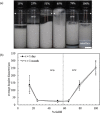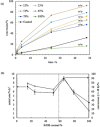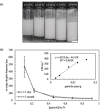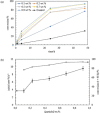Effect of Particle Wettability and Particle Concentration on the Enzymatic Dehydration of n-Octanaloxime in Pickering Emulsions
- PMID: 33119950
- PMCID: PMC7839585
- DOI: 10.1002/anie.202013171
Effect of Particle Wettability and Particle Concentration on the Enzymatic Dehydration of n-Octanaloxime in Pickering Emulsions
Abstract
Pickering emulsion systems have emerged as platforms for the synthesis of organic molecules in biphasic biocatalysis. Herein, the catalytic performance was evaluated for biotransformation using whole cells exemplified for the dehydration of n-octanaloxime to n-octanenitrile catalysed by an aldoxime dehydratase (OxdB) overexpressed in E. coli. This study was carried out in Pickering emulsions stabilised solely with silica particles of different hydrophobicity. We correlate, for the first time, the properties of the emulsions with the conversion of the reaction, thus gaining an insight into the impact of the particle wettability and particle concentration. When comparing two emulsions of different type with similar stability and droplet diameter, the oil-in-water (o/w) system displayed a higher conversion than the water-in-oil (w/o) system, despite the conversion in both cases being higher than that in a "classic" two-phase system. Furthermore, an increase in particle concentration prior to emulsification resulted in an increase of the interfacial area and hence a higher conversion.
Keywords: Pickering emulsions; biphasic catalysis; enzyme catalysis; silica particles.
© 2020 The Authors. Angewandte Chemie International Edition published by Wiley-VCH GmbH.
Conflict of interest statement
The authors declare no conflict of interest.
Figures








Similar articles
-
A comparative study on the capacity of a range of food-grade particles to form stable O/W and W/O Pickering emulsions.J Colloid Interface Sci. 2016 Jul 1;473:9-21. doi: 10.1016/j.jcis.2016.03.060. Epub 2016 Mar 30. J Colloid Interface Sci. 2016. PMID: 27042820
-
Inverse Pickering Emulsion Stabilized by Binary Particles with Contrasting Characteristics and Functionality for Interfacial Biocatalysis.ACS Appl Mater Interfaces. 2020 Jan 29;12(4):4989-4997. doi: 10.1021/acsami.9b16117. Epub 2020 Jan 17. ACS Appl Mater Interfaces. 2020. PMID: 31909591
-
Tailoring Pickering Double Emulsions by in Situ Particle Surface Modification.Langmuir. 2023 Feb 28;39(8):2911-2921. doi: 10.1021/acs.langmuir.2c02266. Epub 2023 Feb 1. Langmuir. 2023. PMID: 36722867
-
Enzyme-particle Complexes Facilitate Pickering Interfacial Biocatalysis.Chempluschem. 2025 Mar;90(3):e202400644. doi: 10.1002/cplu.202400644. Epub 2024 Dec 4. Chempluschem. 2025. PMID: 39617727 Review.
-
Oil-water interfaces of Pickering emulsions: microhabitats for living cell biocatalysis.Trends Biotechnol. 2025 Apr;43(4):790-801. doi: 10.1016/j.tibtech.2024.09.014. Epub 2024 Oct 11. Trends Biotechnol. 2025. PMID: 39395882 Review.
Cited by
-
Stabilizing Triglyceride in Methanol Emulsions via a Magnetic Pickering Interfacial Catalyst for Efficient Transesterification under Static Conditions.ACS Omega. 2021 May 24;6(22):14138-14147. doi: 10.1021/acsomega.1c00629. eCollection 2021 Jun 8. ACS Omega. 2021. PMID: 34124436 Free PMC article.
-
Reaction Engineering for Asymmetric R-/S-PAC Synthesis With Ephedrine or Pseudoephedrine Dehydrogenase in Pickering Emulsion.Eng Life Sci. 2025 Jan 6;25(2):e202400069. doi: 10.1002/elsc.202400069. eCollection 2025 Feb. Eng Life Sci. 2025. PMID: 39990765 Free PMC article.
-
Enzymatic Synthesis of Structured Lipids Enriched with Medium- and Long-Chain Triacylglycerols via Pickering Emulsion-Assisted Interfacial Catalysis: A Preliminary Exploration.Molecules. 2024 Feb 19;29(4):915. doi: 10.3390/molecules29040915. Molecules. 2024. PMID: 38398664 Free PMC article.
-
Pickering Emulsion Biocatalysis with Engineered Living Cells for Degrading Polycarbonate Plastics.Small. 2025 Jul;21(29):e2504376. doi: 10.1002/smll.202504376. Epub 2025 May 24. Small. 2025. PMID: 40411881 Free PMC article.
-
Multiphase Microreactors Based on Liquid-Liquid and Gas-Liquid Dispersions Stabilized by Colloidal Catalytic Particles.Angew Chem Int Ed Engl. 2022 Jan 21;61(4):e202107537. doi: 10.1002/anie.202107537. Epub 2021 Oct 1. Angew Chem Int Ed Engl. 2022. PMID: 34528366 Free PMC article. Review.
References
-
- Chen Z., Zhou L., Bing W., Zhang Z., Li Z., Ren J., Qu X., J. Am. Chem. Soc. 2014, 136, 7498–7504. - PubMed
-
- Schmid A., Dordick J. S., Hauer B., Kiener A., Wubbolts M., Witholt B., Nature 2001, 409, 258–268. - PubMed
-
- Carrea G., Riva S., Angew. Chem. Int. Ed. 2000, 39, 2226–2254; - PubMed
- Angew. Chem. 2000, 112, 2312–2341.
-
- Hinzmann A., Glinski S., Worm M., Gröger H., J. Org. Chem. 2019, 84, 4867–4872. - PubMed
-
- Hashimoto T., Maruoka K., Chem. Rev. 2007, 107, 5656–5682. - PubMed
Publication types
MeSH terms
Substances
LinkOut - more resources
Full Text Sources
Medical

